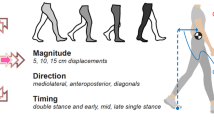Abstract
The remote nature of telepresence scenarios can be seen as a strongpoint and also as a weakness. Although it enables the remote control of robots in dangerous or inaccessible environments, it necessarily involves some kind of communication mechanism for the transmission of control signals. This communication mechanism necessarily involves adverse network effects such as delay. Three mechanisms aimed at improving the effects of network delay are presented in this paper: (1) Motion prediction to partially compensate for network delays, (2) force prediction to learn a local force model, thereby reducing dependency on delayed force signals, and (3) haptic data compression to reduce the required bandwidth of high frequency data. The utilized motion prediction scheme was shown to improve operator performance, but had no influence on operator immersion. The force prediction provided haptic feedback through synchronous forces from the local model, thereby stabilizing the control loop. The developed haptic data compression scheme reduced the number of packets sent across the network by 90%, while improving the quality of the haptic feedback.
Similar content being viewed by others
References
Ferrell, W.R.: Remote manipulation with transmission delay. IEEE Trans. Hum. Factors Electron. HFES 6(1) (1965)
Jeffay, K., Hudson, M., Parris.: Beyond audio and video: multimedia networking support for distributed, immersive virtual environments. In: Proceedings of the Euromicro, pp. 300–307 (2001)
So R.H.Y., Griffin M.J. (1991). Manual control with delays: a bibliography. Comput. Graph. 28: 149–154
Hinterseer, P., Steinbach, E., Chaudhuri, S.: Model based data compression for 3D virtual haptic teleinteraction. In: Proceedings of the IEEE International Conference on Consumer Electronics, Las Vegas, NV, USA (2006)
Hirzinger, G., Heindl, J., Landzettel, K.: Predictive and knowledgebased telerobotic control concepts. In: Proceedings of the IEEE International Conference on Robotics and Automation, pp. 1768–1777 (1989)
Baldwin, J., Basu, A., Zhang, H.: Panoramic video with predictive windows for telepresence applications. In: Proceedings of the IEEE International Conference on Robotics and Automation, Detroit, USA, 10–15 May 1999
Esclusa, J.A., Preusche, C., Hirzinger, G.: Wave variables-based bilateral control with a time delay model for space robot applications. Robotik (2004)
Niemeyer, G., Slotine, J.E.: Towards force-reflecting teleoperation over the internet. In: Proceedings of the 1998 IEEE International Conference on Robotics and Automation, Belgium, pp. 1909–1915 (1998)
Ryu, J., Kwon, D., Hannaford, B.: Stable teleoperation with time domain passivity control. In: Proceedings of the IEEE International Conference on Robotics and Automation, ICRA, Washington, DC, USA, pp. 3260–3265 (2002)
LaViola, J.: Double exponential smoothing: an alternative to Kalman filter-based predictive tracking. In: Proceedings of the Immersive Projection Technology and Virtual Environments, ACM Press, New York, pp. 199–206 (2003)
McNeely, W., Puterbaugh, K., Troy, J.: Six degrees-of-freedom haptic rendering using voxel sampling. In: Proceedings of the SIGGRAPH 99, Los Angeles, CA, USA, pp. 401–408 (1999)
Golle, A., Ulbrich, H., Pfeiffer, F.: Real-time simulation of non-smooth contacts in telepresence and teleaction applications. In: Proceedings of the IEEE International Conference on Industrial Technology ICIT’03, Maribor, Slovenia, pp. 675–679 (2003)
James, D., Pai, D.: ArtDefo—accurate real time deformable objects. In: Proceedings of the Siggraph, Los Angeles, CA, USA, pp. 65–72 (1999)
Pai, D., van den Doel, K., James, D., Lang, J., Lloyd, J., Richmond, J., Yau, S.: Scanning physical interaction behavior of 3D objects. In: Proceedings of the SIGGRAPH, pp. 87–96 (2001)
Kauer, M., Vuskovic, V., Dual, J., Székely, G., Bajka, M.: Inverse finite element characterization of soft tissues. In: Proceedings of the 4th International Conference on Medical Image Computing and Computer-Assisted Intervention (MICCAI), pp. 128–136 (2001)
Clarke, S., Freyberger, F., Pongrac, H., Zäh, M.F.: A virtual scenario to test of an international network and simulated inertia on telepresence performance. In: Proceedings of the IEEE International Conference on Virtual Environments, Human-Computer Interfaces, and Measurement Systems VECIMS, Sicily, Italy, 18–20 July 2005
Clarke, S., Schillhuber, G., Zaeh, M.F., Ulbrich, H.: The effects of simulated inertia and force prediction on delayed telepresence. Presence 16(5), 543–558 (2007)
Massie, T.H., Salisbury, J.K.: The PHANToM haptic interface: a device for probing virtual objects. In: Proceedings of the ASME Winter Annual Meeting, Symposium on Haptic Interfaces for Virtual Environment and Teleoperator Systems, pp. 295–302 (1994)
Markunas, J.: Production and Application of MEMS Stepper Motors. http://www-ee.eng.buffalo.edu/courses/ee541/Project%20Reports/FinalMarkunas_files/frame.htm (2001)]
Clarke, S., Zaeh, M.F., Griebsch, J.: Predicting Haptic data with support vector regression for telepresence applications. HIS 572–558 (2003)
Van der Linde, R.Q., Lammertse, P., Frederiksen, E., Ruiter, B.: The HapticMaster, a new high-performance haptic interface. In: Proceedings of the EuroHaptics, Edinburgh, pp. 1–5 (2002)
Kanjo, R.: Analysis of Pro/ENGINEER V19 Bench98 Benchmark on a Platform Based on the Pentium II Xeon Processor and the 82440GX AGPset. Intel Corporation (1998)
Tschakarow, R.: Programmers Guide for PowerCube: Developing PC Programs for PowerCube Modules, Revision 1.2. Amtec Robotics (2004)
Author information
Authors and Affiliations
Corresponding author
Rights and permissions
About this article
Cite this article
Clarke, S., Schillhuber, G., Zaeh, M.F. et al. Prediction-based methods for teleoperation across delayed networks. Multimedia Systems 13, 253–261 (2008). https://doi.org/10.1007/s00530-007-0103-z
Published:
Issue Date:
DOI: https://doi.org/10.1007/s00530-007-0103-z




